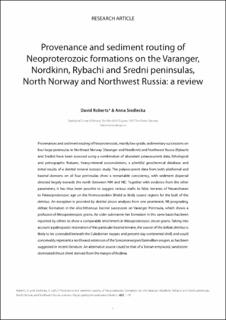| dc.description.abstract | Provenances and sediment routing of Neoproterozoic, mainly low-grade, sedimentary successions on four large peninsulas in Northeast Norway (Varanger and Nordkinn) and Northwest Russia (Rybachi and Sredni) have been assessed using a combination of abundant palaeocurrent data, lithological and petrographic features, heavy-mineral accumulations, a plentiful geochemical database and initial results of a detrital mineral isotopic study. The palaeocurrent data from both platformal and basinal domains on all four peninsulas show a remarkable consistency, with sediment dispersal directed largely towards the north (between NW and NE). Together with evidence from the other parameters, it has thus been possible to suggest various mafic to felsic terranes of Neoarchaean to Palaeoproterozoic age on the Fennoscandian Shield as likely source regions for the bulk of the detritus. An exception is provided by detrital zircon analyses from one prominent, NE-prograding,deltaic formation in the allochthonous basinal succession on Varanger Peninsula, which shows a profusion of Mesoproterozoic grains. An older submarine-fan formation in this same basin has been reported by others to show a comparable enrichment in Mesoproterozoic zircon grains. Taking into account a palinspastic restoration of this particular basinal terrane, the source of the deltaic detritus is likely to be concealed beneath the Caledonian nappes and present-day continental shelf, and could conceivably represent a northward extension of the Sveconorwegian\/Grenvillian orogen, as has been suggested in recent literature. An alternative source could be that of a Tonian-emplaced, sandstonedominated thrust sheet derived from the margin of Rodinia. | |

